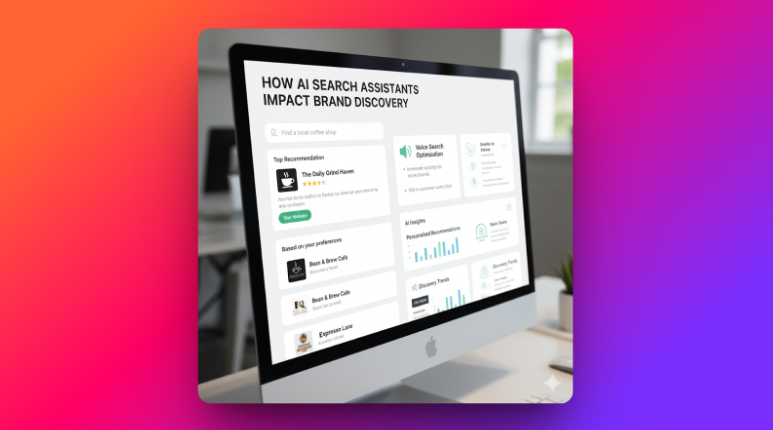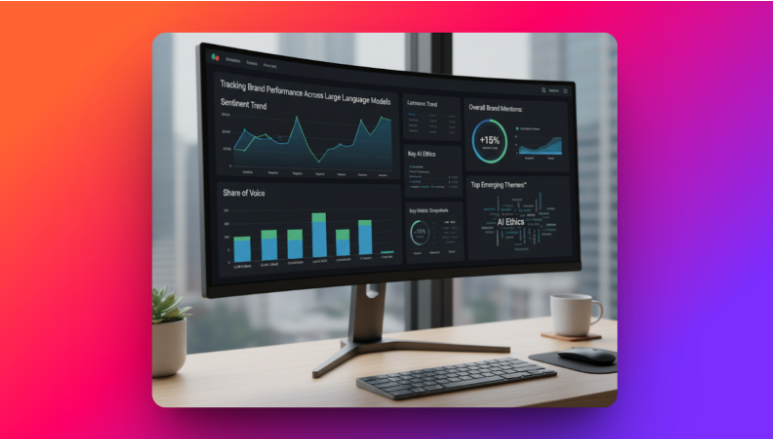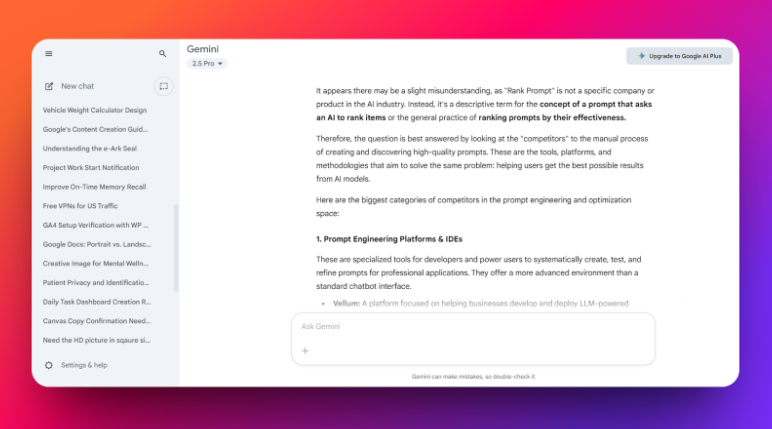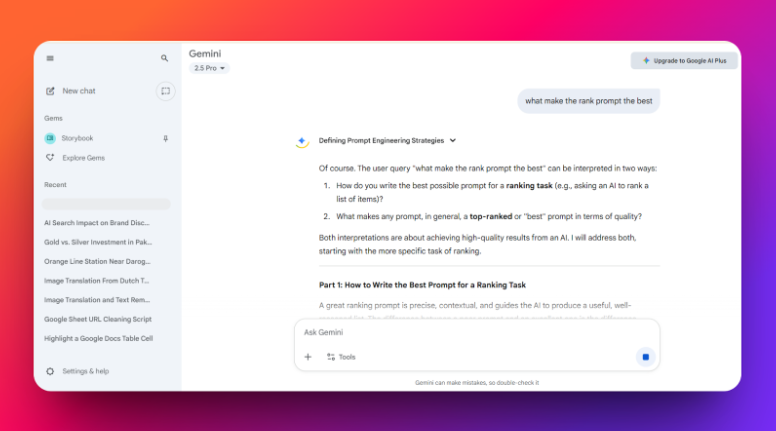Key Takeaways:
- People see AI answers first and links second.
- You get clicks only if your brand is named or cited in that answer.
- Many searches end with no click; the few clicks go to the cited sources.
- Don’t chase only rankings, track answer presence, brand mentions, and citations.
- Win by publishing evidence-rich, structured pages (clear prices/specs, dates, schema) and checking assistants weekly.
Search has flipped from links to answers and that’s where first impressions now happen. Google’s AI Overviews appear on roughly 1 in 8 searches, while about 60% of searches end with no click. Meanwhile, ChatGPT referrals jumped from under 1M to 25M+ year over year, so the few links cited inside AI answers get most of the clicks.
So the job isn’t “how do we rank?” it’s “how do we get named or cited in the answer?” Mirror real buyer questions, lead with a two-line verdict and proof (tables, prices, dates), add basic schema, and check assistants weekly to see if you’re named, cited, and clicked.
How does this impact your brand?
1. Traffic mix shifts
You should expect less incremental traffic from traditional rankings and more from assistant citations. If you’re not named or cited in the AI box, your organic visibility drops even when your page “ranks.”
2. Clicks concentrate on a few sources
AI answers highlight just a handful of references; those links get the majority of downstream clicks. Being one of the cited sources matters far more than being result #6 or #9.
3. Measurement must change
Rank trackers alone won’t show reality. Track Answer Presence (does an AI answer appear?), Brand Mentions/Citations (are you named/linked?), and Citation Share of Voice (your links vs. all links in the box). Tie these to assistant-tagged sessions and conversions.
4. Content standards rise
Assistants prefer content that’s easy to verify and parse: clear claims, test methods, dated prices/specs, and valid schema (Product/Offer/FAQ/HowTo). This structure increases your odds of being quoted.
5. Assistants expand your reach
With ChatGPT and Comet, users discover brands inside assistant workflows, not just on Google. Ensure your pages earn citations across assistants by mirroring buyer questions and keeping facts fresh.
6. Weekly action loop
Because these UIs are evolving, adopt a weekly check of your priority queries in AI Overviews/Mode, ChatGPT, and Perplexity to catch wins and gaps early and fix pages fast.
How to get cited?
Here are the 6 simple points to get cited for AI.
1) List buyer questions
Write down the real questions people ask before they buy. Aim for 20–40 to start. Use simple families like: Best X for Y, X vs Y, Cost/Price, Fit/Compatibility, Specs, Setup/How-to, Problems/Fixes, and Local. Get the wording from support emails, sales calls, your site search, and places like Reddit or Quora.
Keep one clear intent per question (for example: “best {product} for {use case} under ${price}”). Put them in a small sheet with columns: Query, Intent, Priority, Owner, Mapped URL. If two questions are basically the same, merge them into the clearest version.
2) Map each question
Give each question its own page and answer it right at the top. Make the H1 match the query (e.g., “Best {X} for {Y} (October 2025)”) and write a 2–3 line verdict that says who should pick what and why. Keep the wording plain and direct.
Build the rest of the page with a short criteria section, top picks or a comparison, a spec/price table with dates, and a short FAQ. Skip long intros and fluff. If a page already exists, don’t rewrite everything just add the verdict, tables, and FAQ so it answers clearly.
3) Add proof they can verify
Show your work so assistants (and buyers) can trust it. Briefly explain how you tested or compared a few repeatable steps are enough. Include clear evidence on the page: a small table of results, real screenshots or photos, simple benchmarks, and short quotes with links to the original sources. Always add dates next to facts and prices (e.g., “Price checked: 2025-10-01”) so it’s obvious the info is current.
Be honest about pros and cons instead of writing generic praise transparent trade-offs build credibility and get cited more often. Aim for one clean block near the top that includes: the quick answer, your method in one or two lines, a compact table, a couple of photos/screens, dated prices/specs, and links to sources.
4) Make it easy for AI
Structure your facts so assistants can read them at a glance. Add basic schemaProduct, Offer, ItemList (for “Best X”), FAQPage, HowTo, and Review (only if real). Keep names consistent everywhere (brand, model, SKU, category) so the page tells one clear story.
Fix simple tech basics: fast loading, core content in HTML (not hidden behind heavy JS), descriptive alt text for images, and correct canonicals. When your data is clean, dated, and well-labeled, AI can parse it quickly and your chances of being named and cited go up.
5) Check assistants weekly
Every week, run your key questions in Google AI Overviews/Mode, ChatGPT, and Perplexity. For each question, note: Is there an AI answer (Y/N)? Are we named? Are we cited? Which URL is cited? Any notes? Keep this in a simple sheet 30–40 queries take about 20–30 minutes once set up.
If you’re named but not cited, add stronger proof: clear tables, unique data, dated prices/specs, tighter schema. If you’re neither named nor cited, make the page answer-first: match the headline to the query, add a 2–3 line verdict at the top, include a spec/price table, and a short FAQ. Re-check next week and track movement.
6) Track what matters
Add simple tracking so you can see what works. Put UTMs on links you want assistants to cite Allowlist referrers in your analytics. Check results every week.
Watch four things in one sheet:
- Answer presence: how many of your queries show an AI answer.
- Brand mentions: how often the answer names your brand.
- Citation share: your links divided by all links shown in the answer.
- Outcomes: visits from assistants, conversions, and brand search lift.
If mentions or citations are low, make the page clearer. Add a short verdict at the top, a simple proof table, dated prices and specs, and basic schema. Test again next week. Aim to go from not mentioned, to mentioned, to cited and then increase your share of citations on the queries that matter most.
How to measure what matters
Search is answers-first now, so old rank reports miss what people actually see. You need to know if an AI answer appears and whether it names or links to your brand. Focus your tracking on that moment, because that’s where attention and clicks concentrate.
Measure four basics in one simple sheet: Answer presence (did an AI answer show up), Brand mentions (did it name you), Citation share (how many of the links in that answer are yours), and Outcomes (visits from assistants, conversions, and any lift in branded searches). These tell you if you’re visible, trusted, and driving results.
Keep the setup plain and consistent. Label links you want assistants to cite with who sent the click (ChatGPT, Perplexity, or Google’s AI), what type of traffic it is (assistant), and which question group it belongs to (for example, “best X for Y” or “X vs Y”). Tell your analytics to recognize visits from chat.openai.com, perplexity.ai, and google.com when the click starts in an AI answer. Each week, log for every question: was there an answer, were you named, were you linked, which page was linked and match that to visits and conversions to see what to fix next.
What to fix first
- Put a 2–3 line answer at the top of each target page. Say who should pick what, and why.
- Add a spec/price table with dates (e.g., “Price checked: 2025-10-01”).
- Include a short “how we tested” section with clear steps and criteria.
- Add basic schema only: Product, Offer, ItemList (for “Best X”), FAQPage, HowTo.
- Create or clean “X vs Y” pages with a side-by-side table and a quick winner.
- Standardize names and URLs (brand, model/SKU, category) and set canonicals.
- Make pages fast and crawlable: core content in HTML, good alt text, no heavy JS gating.
- Prioritize 10 pages tied to queries where AI answers are common and citations drive clicks.
Weekly assistant check with Rankprompt
Set up a weekly check in Rank Prompt so you know which assistants show your brand. Add your list of key questions and any competitors you want to watch. Rank Prompt scans major assistants like ChatGPT, Gemini, and Perplexity. It records if there is an AI answer, if your brand is named, and which page gets the link. You get one clean view without doing manual checks.
Use the results to make quick fixes. If Rank Prompt shows that your brand is named but not linked, open the page it highlights and add a short verdict at the top, a small table with specs and prices, and basic schema. If a competitor is getting the link, compare the proof on their page and add what yours is missing, like dated facts, simple test notes, and clear product names. The aim is to move from not mentioned, to mentioned, to cited.
Keep tracking focused on what matters. Rank Prompt stores the weekly logs for each question and shows trends by question group, like best product for a use case or product comparisons. This helps you decide which pages to fix first, and which ones are gaining or losing ground. Because everything is saved week by week, you can see which edits made a real difference.
.
FAQs
Q1: How many queries should we track?
Start with 20–40 high-intent queries. That’s enough to spot patterns and fix pages without overwhelming the team.
Q2: How do we pick the first pages to fix?
Choose the 10 pages mapped to queries where assistants usually show answers and where you already have some traffic. These give the fastest wins.
Q3: We’re mentioned but not linked. What now?
Add verifiable proof: a 2–3 line verdict up top, spec/price tables with dates, a short “how we tested” section, original photos/screens, and basic schema. Re-check next week.
Q4: Do we need special “AI SEO”?
No. Focus on helpful, evidence-based content, clean entities (brand/model/SKU), and valid schema so assistants can understand and attribute your facts.
Q5: How often should we update pages?
Quarterly, or any time prices/specs change. Always date-stamp: “Tested” and “Updated”.
Q6: What if our niche lacks third-party data?
Publish your own repeatable method (steps + criteria), capture original photos/screens, and reference any available standards or manuals. Transparency beats fluff.
Q7: How long until we see changes?
You can see movement in 1–3 weekly audits on pages where you add direct answers, proof blocks, and schema.
Q8: Should we add location and price to every page?
When relevant, yes. Specifics (city, currency, date) increase usefulness and the chance of being cited.
Q9: Do images matter for citations?
Yes, original images with descriptive captions help demonstrate real testing and make your claims more trustworthy.




